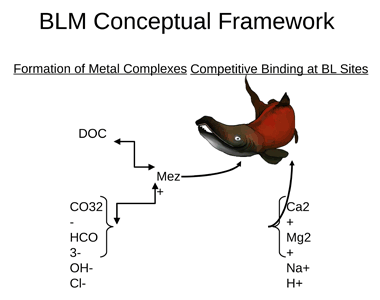The biotic ligand model (BLM) is a tool that uses a mechanistic approach to predict the bioavailability of several metals under the large range of water chemistry conditions that are observed in nature. The BLM is scientifically robust and defensible, user friendly, and freely available for download from this website.
The bioavailability of metals in aquatic systems (i.e., the amount of metal that is available for uptake by organisms) is highly dependent on several factors. For example, dissolved organic carbon (DOC) in the water binds metals, thereby reducing their bioavailability. Alkalinity can contribute bicarbonate and carbonate ions, which can reduce metal bioavailability in a similar manner. Cations (such as calcium) reduce bioavailability by competing with metals for uptake by an organism. Finally, pH can affect metal speciation (at high pH) or can result in competition with metal uptake (at low pH). For a metal like copper, bioavailability is greatest in waters with low DOC, low hardness, and low pH; bioavailability generally decreases as any one of the parameters increases. Other metals, such as aluminum, have more complex speciation. For example, highly bioavailable forms of aluminum can occur at both pH 6 and 8, but less bioavailable forms occur at pH 7.
In 2007, the US Environmental Protection Agency (EPA) adopted freshwater ambient water quality criteria (AWQC) for copper based on the BLM; as of today, several states have adopted BLM-based criteria or the BLM as a tool for developing site-specific copper criteria. In addition to copper, BLM-based, environmentally protective levels for several other metals have been, or are currently being, developed: aluminum, cadmium, cobalt, lead, nickel, silver, and zinc.
The BLM is a powerful tool not only for evaluating regulatory compliance, but also for using in site-specific risk assessments, including evaluations of both surface water and sediment porewater. For the latter, the BLM can help reduce the substantial uncertainty associated with bulk sediment guidelines that do not account for bioavailability. Lastly, the BLM provides a framework for evaluating the bioavailability of metal mixtures, which is almost always of interest at sites with elevated metals concentration.

